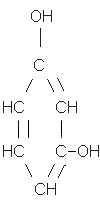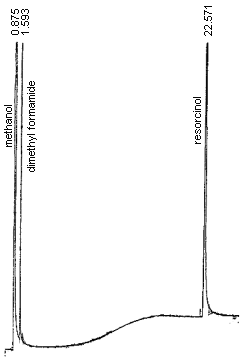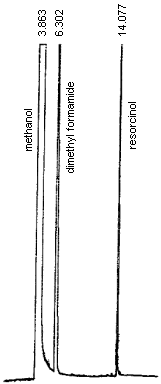RESORCINOL
| Method number: | PV2053 |
| Matrix: | Air |
| Target concentration: | 10 ppm (45 mg/m3) OSHA TWA PEL 20 ppm (90 mg/m3) OSHA STEL (Note: These are the 1989 levels which have subsequently been rescinded.) |
| Procedure: | Samples are collected by drawing a known volume of air through
an |
| Air volume and sampling rate studied: | 60 liters at 1.0 Lpm |
| Status of method: | Stopgap method. This method has been only partially evaluated and is presented for information and trial use. |
| Date: March, 1992 Revised: March, 1994 |
Chemist: Mary E. Eide |
Organic Service Branch I
OSHA Salt Lake Technical
Center
Salt Lake City, Utah
1. General Discussion
- 1.1. Background
- 1.1.1. History of procedure
The OSHA Technical Center has received many requests for a
sampling and analytical procedure for resorcinol. OSHA promulgated
an exposure standard for resorcinol in January, 1989, at a level of
10 ppm TWA, and 20 ppm STEL. OSHA method 32 recommends collection of
phenol and cresol on
1.1.2. Potential workplace exposure (Ref. 5.2.)
Resorcinol is used in the tanning and dyeing industries; in the manufacture of resins and resin adhesives, explosives, hexyl resorcinol, p-aminosalicylic acid, cosmetics, and as an antiseptic and topical antipruritic.
1.1.3. Toxic Effects (This section is for information purposes and should not be taken as the basis for OSHA policy.)(Ref. 5.3.)
Resorcinol is a skin, eye, and mucous membrane irritant. Exposure to resorcinol causes, with increasing exposure, skin burns, cyanosis, methemoglobinemia, convulsions, and death. It was found to be less toxic than phenol, but with similar toxic effects.
1.1.4. Physical properties (Ref. 5.2.):
| Compound: |  |
| Synonyms: | 1,3-Benzenediol; Resorcin;
|
| Molecular weight: | 110.11 |
| Melting point: | 110°C |
| Boiling point: | 280°C |
| Flash point: | 127°C (261°F)(closed cup) |
| Odor: | phenolic |
| Color: | white, turns pink on exposure to light or air |
| Molecular formula: | C6H6O2 |
| CAS: | 108-46-3 |
| IMIS: | 2221 |
| RTECS: | VG962500; 76367 |
| DOT: | UN2876 (Poison) |
1.2. Limit defining parameters
- 1.2.1. The detection limit of the analytical procedure is 8 µg
resorcinol. This is the smallest amount that could be detected under
normal operating conditions.
1.2.2. The overall detection limit is 0.0889 ppm. (All ppm amounts in this study are based on a 20 L air volume.)
1.3. Advantages
- 1.3.1. The sampling procedure is convenient.
1.3.2. The analytical method is reproducible and sensitive.
1.3.3. Reanalysis of samples is possible.
1.3.4. It may be possible to analyze other compounds at the same time.
1.3.5. Interferences may be avoided by proper selection of column and GC parameters.
1.4. Disadvantages
none known
2. Sampling procedure
- 2.1. Apparatus
- 2.1.1. A calibrated personal sampling pump, the flow of which
can be determined within ± 5% at the recommended flow.
2.1.2. An
2.2. Sampling technique
- 2.2.1. Open the ends of the
2.2.2. Connect
2.2.3. Place the tubes in a vertical position to minimize channeling, with the smaller section towards the pump.
2.2.4. Air being sampled should not pass through any hose or
tubing before entering the
2.2.5. Seal the
2.2.6. With each batch of samples, submit at least one blank tube from the same lot used for samples. This tube should be subjected to exactly the same handling as the samples (break ends, seal, & transport) except that no air is drawn through it.
2.2.7. Transport the samples (and corresponding paperwork) to the lab for analysis.
2.2.8. Bulks submitted for analysis must be shipped in a separate container from other samples.
2.3. Desorption and Extraction efficiency
- 2.3.1. Six glass fiber filters were spiked at loadings of 0.298
mg (1.10 ppm), 1.49 mg (5.51 ppm), 2.98 mg (11.0 ppm), and 5.96 mg
(22.1 ppm) resorcinol. They were allowed to equilibrate overnight at
room temperature. They were opened, desorbed with 2 mL of methanol
for 30 minutes with shaking, and analyzed by
Extraction Efficiency of Glass Fiber Filters
|
| ||||
| Filter# | % Recovered | |||
| 0.298 mg | 1.49 mg | 2.98 mg | 5.96 mg | |
|
| ||||
| 1 | 102 | 96.8 | 99.3 | 99.6 |
| 2 | 98.9 | 99.4 | 98.8 | 100 |
| 3 | 102 | 96.8 | 102 | 98.8 |
| 4 | 101 | 101 | 98.9 | 99.8 |
| 5 | 97.6 | 103 | 99.8 | 102 |
| 6 | 102 | 103 | 100 | 100 |
| average | 101 | 100 | 99.8 | 100 |
| overall average 100 | ||||
| standard deviation ± 1.78 | ||||
|
| ||||
2.3.2. Six front portions of
Desorption Efficiency of XAD-7
|
| |||
| Tube# | % Recovered | ||
| 89.9 µg | 450 µg | 899 µg | |
|
| |||
| 1 | 101 | 98.3 | 100 |
| 2 | 98.0 | 96.8 | 101 |
| 3 | 99.4 | 100 | 102 |
| 4 | 102 | 101 | 99.2 |
| 5 | 97.3 | 102 | 99.6 |
| 6 | 102 | 102 | 101 |
| average | 100 | 100 | 100 |
| overall average 100 | |||
| standard deviation ± 1.71 | |||
|
| |||
2.4. Retention efficiency
Nine
Retention Efficiency with 60 liters Humid Air
|
| ||||
| Tube # | % Recovered | % Recovered | % Recovered | Total |
| GFF | Front XAD-7 | Back XAD-7 | ||
|
| ||||
| 1 | 96.9 | 2.4 | 0.0 | 99.3 |
| 2 | 98.6 | 2.6 | 0.0 | 101 |
| 3 | 94.1 | 5.7 | 0.0 | 99.8 |
| 4 | 96.8 | 2.8 | 0.0 | 99.6 |
| 5 | 95.6 | 2.9 | 0.0 | 98.5 |
| 6 | 97.5 | 2.4 | 0.0 | 99.7 |
| average | 99.7 | |||
|
| ||||
Retention Efficiency with 180 liters Humid Air
|
|
||||
| Tube # | % Recovered | % Recovered | % Recovered | Total |
| GFF | Front XAD-7 | Back XAD-7 | ||
|
|
||||
| 1 | 91.8 | 7.8 | 0.0 | 99.6 |
| 2 | 92.0 | 7.4 | 0.0 | 99.4 |
| 3 | 93.0 | 7.2 | 0.0 | 100 |
| average | 99.7 | |||
|
| ||||
2.5. Storage
Tubes were spiked with 899 µg (9.98 ppm) resorcinol and stored at room temperature until opened and analyzed. Since resorcinol may decompose in light, half of the tubes were stored under room light, and half were stored in darkness. The samples were found to be stable, for the 14 days stored, under both conditions. The recoveries averaged 98.5%.(Table 5)
Storage Study
|
| ||
| Day | % Recovered light | % Recovered dark |
|
| ||
| 7 | 101 | 101 |
| 7 | 98.1 | 96.1 |
| 7 | lost | 99.0 |
| 14 | 102 | 98.5 |
| 14 | 97.9 | 94.7 |
| 14 | 101 | 94.2 |
| overall average | 98.5 | |
|
| ||
2.6. Precision
The precision was calculated using the area counts from six injections of each standard at concentrations of 89.9, 450, 899, and 1798 µg/mL resorcinol in the desorbing solution. The pooled coefficient of variation was 0.00924.(Table 6)
Precision Study
|
| ||||
| Injection | ||||
| Number | 89.9 µg/mL | 450 µg/mL | 899 µg/mL | 1798 µg/mL |
|
| ||||
| 1 | 15459 | 84017 | 157575 | 300122 |
| 2 | 15037 | 84092 | 157999 | 298006 |
| 3 | 15436 | 83171 | 156893 | 300985 |
| 4 | 15610 | 82527 | 158541 | 298940 |
| 5 | 15068 | 82572 | 156349 | 299382 |
| 6 | 15323 | 82670 | 158489 | 300375 |
| Average | 15322 | 83175 | 157641 | 299635 |
| Standard | ||||
| Deviation | ± 228 | 720 | 882 | 1078 |
| CV | 0.0149 | 0.00866 | 0.00560 | 0.00360 |
| Pooled CV | 0.00924 | |||
|
| ||||
where:

A(1), A(2),A(3),A(4) = # of injections at each
level
CVl, CV2, CV3, CV4 = Coefficients at each level
2.7. Air volume and sampling rate studied
- 2.7.1. The air volume studied is 60 liters.
2.7.2. The sampling rate studied is 1.0 liters per minute.
2.8. Interferences
Suspected interferences should be listed on sample data sheets.
2.9. Safety precautions
- 2.9.1. Sampling equipment should be placed on an employee in a
manner that does not interfere with work performance or safety.
2.9.2. Safety glasses should be worn at all times in designated areas.
2.9.3. Follow all safety practices that apply to the workplace being sampled.
3. Analytical method
- 3.1. Apparatus
- 3.1.1. Gas chromatograph equipped with a flame ionization
detector. A HP5890 gas chromatograph was used in this study.
3.1.2. GC column capable of separating the analyte and an
internal standard from any interferences. The column used in this
study was a 30 meter
3.1.3. An electronic integrator or some other suitable method of measuring peak areas.
3.1.4. Two milliliter vials with
3.1.5. A 10 µL syringe or other convenient size for sample injection.
3.1.6. Pipets for dispensing the desorbing solution. The Glenco 1 mL dispenser was used in this method.
3.1.7. Volumetric flasks - 5 mL and other convenient sizes for preparing standards.
3.2 Reagents
- 3.2.1. Purified GC grade nitrogen, hydrogen, and air.
3.2.2. Resorcinol, Reagent grade
3.2.3. Methanol, HPLC grade
3.2.4. Dimethyl formamide, Reagent grade
3.2.5. Desorbing solution is methanol with 1 µL/mL dimethyl formamide used as an internal standard.
3.3. Sample preparation
- 3.3.1. Sample tubes are opened and the glass fiber filter,
front, and back sections of each tube are placed in separate 4 mL
vials. If particulate analysis is not desired the glass fiber filter
is added to the vial containing the front section.
3.3.2. Each section is desorbed with 2 mL of the desorbing solution.
3.3.3. The vials are sealed immediately and allowed to desorb for 30 minutes with occasional shaking.
3.3.4. An aliquot was removed and placed into 2 mL vials for analysis with the autosampler. This step may not be necessary, depending on the type of instrumentation used for analysis.
3.4. Standard preparation
- 3.4.1. Standards are prepared by diluting a known quantity of
resorcinol with the desorbing solution.
3.4.2. At least two separate stock standards should be made, and dilutions bracketing the samples are prepared. In this study, the analytical standards ranged from 8 to 5960 µg/mL resorcinol in the desorbing solution.
3.5. Analysis
- 3.5.1. Gas chromatograph conditions
| Flow rates (mL/min) | Temperature (°C) | ||
| Nitrogen(makeup) | :30 | Injector | :240 |
| Hydrogen(carrier) | :1.5 | Detector | :240 |
| Air | :450 | Column | :110°-1 min |
| Hydrogen(detector) | :30 | 4°C/min-160°C | |
| Injection size | :1 µL | ||
| Elution time | :22.566 min | ||
| Chromatogram | :(See Figure 1) | ||
3.5.2. Gas chromatograph conditions
| Flow rates (mL/min) | Temperature (°C) | ||
| Nitrogen(makeup) | :30 | Injector | :220 |
| Hydrogen(carrier) | :1.5 | Detector | :240 |
| Air | :450 | Column | :80°-0 min |
| Hydrogen(detector) | :30 | 10°C/min-220°C | |
| Injection size | :1 µL | ||
| Elution time | :14.077 min | ||
| Chromatogram | :(See Figure 2) | ||
3.5.3. Peak areas are measured by an integrator or other suitable means.
3.6. Interferences (analytical)
- 3.6.1. Any compound having the general retention time of the
analyte or the internal standard used is an interference. Possible
interferences should be listed on the sample data sheet. GC
parameters should be adjusted if necessary so these interferences
will pose no problems.
3.6.2. Retention time data on a single column is not considered proof of chemical identity. Samples over the target concentration should be confirmed by GC/Mass Spec or other suitable means.
3.7. Calculations
- 3.7.1. A curve with area counts versus concentration is
calculated from the calibration standards.
3.7.2. The area counts for the samples are plotted with the calibration curve to obtain the concentration of resorcinol in solution.
3.7.3. To calculate the concentration of analyte in the air sample the following formulas are used:
| (µg/m) (desorption volume)
(desorption efficiency) |
= mass of analyte in sample |
| (mass of analyte in sample)
molecular weight |
= number of moles of analyte |
| (number of moles of analyte) |
(molar volume at 25°C & 760mm) |
= | volume the analyte
will occupy at 25°C & 760mm |
| (volume analyte occupies)
(106)*
(air volume) |
= ppm |
* All units must cancel.
3.7.4. The above equations can be consolidated to form the following formula. To calculate the ppm of analyte in the sample based on a 20 liter air sample:
| (µg/mL)(DV)(24.45)(106)
(60 L)(DE)(MW) |
× | (g)
(1000 mg) |
× | (mg)
(1000 µg) |
= ppm |
| µg/mL | = | concentration of analyte in sample or standard |
| 24.45 | = | Molar volume (liters/mole) at 25° and 760 mm Hg. |
| MW | = | Molecular weight (g/mole) |
| DV | = | 2 mL Desorption volume |
| 60 L | = | 10 liter air sample |
| DE | = | Desorption efficiency |
3.7.5. This calculation is done for each section of the sampling tube and the results added together.
3.8. Safety precautions
- 3.8.1. All handling of solvents should be done in a hood.
3.8.2. Avoid skin contact with all chemicals.
3.8.3. Wear safety glasses, gloves and a lab coat at all times.
4. Recommendations for further study
A collection study should be performed.

Figure 1. An analytical standard of 450 µg/mL resorcinol in methanol with 1 µL/mL dimethyl formamide internal standard.

Figure 2. An analytical standard of 450 µg/mL resorcinol in methanol with 1 µL/mL dimethyl formamide internal standard.
5. References
- 5.1. Cummins,K., Method 32, "Phenol and Cresol", Organic Methods
Evaluation Branch, OSHA Salt Lake Technical Center, 1986.
5.2. Windholz, M., "The Merck Index", Eleventh Edition, Merck & Co., Rahway N.J., 1989, p. 1176.
5.3. "Documentation of the Threshold Limit Values and Biological Exposure Indices", Fifth Edition, American Conference of Governmental Industrial Hygienists Inc., Cincinnati, OH, 1986, p. 511.